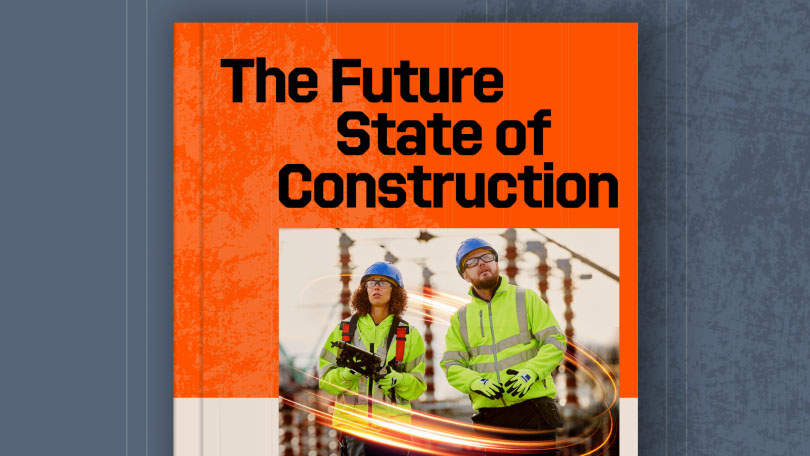— 7 min read
UK Construction Subcontractor Types


Last Updated Nov 25, 2025

Tom Scalisi
Contributing Writer
59 articles
Tom Scalisi is a writer with over 15 years of experience in the trades. He is passionate about educating contractors and specialty contractors about the best practices in the industry. He has seen first-hand how education, communication, and preparation help construction professionals overcome challenges to build a strong career and thriving business in the industry.

Brian Davis
Senior Product Marketing Manager
Brian Davis is a Senior Product Marketing Manager at Bluebeam with a history of working across multiple industries and businesses of all sizes. His experience is rooted in marketing strategy, SEO, digital marketing, and recruitment. Brian has a MBA focused on Marketing and International Business from Arizona State University, W. P. Carey School of Business.

Nicholas Dunbar
Content Manager
62 articles
Nick Dunbar oversees the creation and management of UK and Ireland educational content at Procore. Previously, he worked as a sustainability writer at the Building Research Establishment and served as a sustainability consultant within the built environment sector. Nick holds degrees in industrial sustainability and environmental sciences and lives in Camden, London.

Zoe Mullan
27 articles
Zoe Mullan is an experienced content writer and editor with a background in marketing and communications in the e-learning sector. Zoe holds an MA in English Literature and History from the University of Glasgow and a PGDip in Journalism from the University of Strathclyde and lives in Northern Ireland.
Last Updated Nov 25, 2025

Construction projects require a variety of companies to collaborate and bring a contract to a successful completion. Generally, one company manages the project and hires other companies – known as subcontractors – to carry out specialised scopes of work. This scenario also applies to contractor and subcontractor tiers in a contract, with a main contractor (MC) running the show, and several types of specialty contractors working on various projects within the main job.
The term 'contractor' can describe anyone who works on a construction project. However, there are actually significant differences between various types of contractors. In this article, we take an in-depth look at what separates them. We’ll also cover different types of subcontractors and the tasks they perform, to clarify any misconceptions.
Table of contents
Defining Subcontractors
To the world beyond the hammers, nails, excavators and drawings, 'contractor' tends to describe everyone who builds anything. But the term refers to anyone hired to perform work or services under a contract.
A company that enters into a contract with a project owner on any type of construction project – whether a residential building, a commercial entity, or a local authority – serves as the prime or main contractor (MC). This organisation receives appointment by the project owner to organise and run the project.
A subcontractor, however, describes any contractor that a party other than the owner hires. The MC or another subcontractor may engage subcontractors. These contractors usually specialise in a specific area of work and are often referred to as specialty contractors or trade contractors. A subcontractor does not function as an employee and is responsible for their own tax and National Insurance, carrying their own Public & Employers' Liability insurance, and remains liable for their workmanship rather than overall delivery.
Learn about the future of the built environment - Read Procore's Future State of Construction report
Learn how contractors, subcontractors, and project teams can take advantage of new opportunities to boost efficiency and profitability over the next decade. Download the report to get your roadmap to the future state of construction.

Project Hierarchy Example
- Owner → Main contractor
- Main contractor → hires specialty contractors as subcontractors
- Subcontractor → carries out tasks such as electrical wiring, drylining installation, or steel framing
- Sub-subcontractor → engaged on large projects to deliver an even more specialised element

UK Subcontractor Classifications
UK projects operating under JCT or NEC contractsusually recognise three common subcontractor categories:
| Classification | Who appoints? | Typical contract reference |
| Domestic subcontractor | Main contractor | JCT SBC 2016/2024 (Standard Provisions) |
| Named subcontractor | Client selects; MC employs | JCT SBC 2016/2024 (Supplemental Provisions) |
| Nominated subcontractor | Client supplies shortlist; MC tenders and lets package | Obsolete in modern JCT (Historical reference only) |
Understanding the correct classification helps manage risk, allocate design responsibility, and clarify payment processes.
Subcontractor Tiers and Responsibilities
Tier 1
Subcontractors holding direct contracts with the principal (main) contractor.
Tier 2
Specialists or suppliers that Tier 1s hire.
Tier 3
Niche trades or plant-hire firms supporting Tier 2s.
Contract conditions, CDM 2015 duties, and payment terms flow down each tier – so a Tier 3 dryliner must follow the same risk assessments and payment terms compliant with the Construction Act.
Under CDM 2015, the main contractor plans, manages, and monitors health, safety and welfare for every subcontractor on site. Higher-risk buildings must also meet additional obligations outlined in the Building Safety Act 2022.
Common Subcontractor Specialities
Groundworks and Site Preparation
Before a project can start, some MCs hire a groundworks contractor to prepare the site. This contractor brings heavy plant to create access roads, remove trees, level the plot and excavate foundations. On smaller jobs, the MC might self-deliver, or a concrete specialist might hire its own sub-subcontractor.
Concrete
The concrete contractor pours the foundation, footings or other cement-based structures. Generally, this contractor enters into a contract directly with the MC to lay the groundwork. They might also pour driveway concrete, walkways and patios. Concrete contractors may work with precast elements such as walls, beams and culverts, manufactured off-site and delivered for installation.
Structural and Framing
A building's structure and framing could comprise timber, steel or concrete. Some MCs may handle timber framing themselves but often hire a framing subcontractor to build wall and roof components. Framing contractors may also install exterior sheathing, windows and doors. Large steel structures require a steel-erection contractor, who in turn may hire a crane company as a sub-subcontractor.
Roofing, Claddingm and Sheet-Metal Work
When it comes to drying-in the building envelope – enclosing the structure to protect interiors from the weather – MCs typically hire roofing, cladding, glazing, stucco and sheet-metal contractors. Many fabricate windows, wall panels and roof sections in their workshops before rapid on site installation.
Plumbing and M&E
Plumbers focus on getting water into and out of the building. They install waste pipes, vents and water feeds, then connect to the local mains water supply or a private well. Qualified engineers on the Gas Safe Register handle gas work. Mechanical & Electrical (M&E) contractors often combine plumbing, HVAC and gas scopes.
HVAC and M&E
Heating, ventilation and air-conditioning (HVAC) subcontractors ensure the building's climate remains safe and comfortable. They install boilers, ductwork and air-conditioning units. HVAC firms are often classified as mechanical contractors and may also deliver plumbing and gas packages.
Electrical
Electrical contractors work on every site. They install panels, cabling, fixtures, generators and transfer switches the MC lacks a licence to fit. For new or heavily renovated projects, they set up temporary power. Domestic work must comply with Part P of the Building Regulations, and most firms hold certification by NICEICor ECA.
Carpentry
While the MC or a framing contractor usually frames the main structure, much of the interior work goes to the carpentry subcontractor. Carpenters fit millwork – trim, cabinetry and internal doors – plus floors and decorative accents. Some specialise solely in doors, trim and cabinetry; others cover flooring as well.
Masonry and Stonework
Specialist masonry contractors handle brick and stone surfaces. They possess the tools and skills to lay brick or block courses and may also undertake small concrete repairs.
Drylining and Plastering
Drylining contractors specialise in installing, repairing and finishing plasterboard systems (traditionally called drywall). Most projects – residential or commercial – require interior drylining, so their services remain in high demand. They fix boards to framing, then tape and joint the seams. Depending on capability and contract, they may also apply texture, paint or wallpaper.
Painting and Paper Hanging
To bring a space to life with colour and pattern, the MC hires a painting and paper-hanging contractor. Painters prepare surfaces by masking, sanding, priming and caulking, then apply coatings with a keen eye for detail.
Tile-setting
Any tile work – floors, showers, splashbacks, lobbies, or accent walls – is handled by a tile-setting contractor. These specialists know which materials perform best and how to source rare tiles. Some also lay timber or vinyl flooring.
Managing Multiple Specialities
The construction industry encompasses numerous specialties needed to bring a project to completion – this article covers just a few. Trade coordination proves essential, and the MC must manage project programmes so trades don't conflict with one another.
Keeping up with who works where and when affects programme, budget, quality and safety. Accurate subcontractor classification helps mitigate risk, cut rework and reduce costly disputes. Clear tiers and well-sequenced programmes boost productivity, and digital tools that capture real-time labour and materials data empower data-driven decisions. Having an expert understanding of how each trade operates proves critical for an MC to deliver a project on time and on budget.
Key Takeaways
- Three UK subcontractor classifications: domestic, named and nominated (obsolete)
- CDM 2015 and the Building Safety Act 2022 set safety duties across every tier
- Clear responsibilities and programmes improve risk control, cost and productivity
FAQs
What is the difference between a domestic and a nominated subcontractor?
A domestic subcontractor receives selection and contract directly by the main contractor. A nominated subcontractor receives selection by the client and formal instruction via the main contractor, usually under JCT clause 6.3. However, the term is obsolete in modern JCT, and is typically used for historical reference only.
Who is responsible for CDM 2015 compliance on site?
The principal contractor – generally the main contractor – coordinates CDM duties for every subcontractor and tier.
Do subcontractors need insurance?
Yes. Each subcontractor must carry its own Public & Employers' Liability insurance and, where appropriate, Professional Indemnity cover.
Free Download
Bill of Quantities Template
Many construction professionals in charge of creating a Bill of Quantities use templates like this to make the process more efficient and simple. They use common data processing computer programmes for organising and calculation, removing some of the problems associated with human error.
- Free starter template
- Ready-to-use
- Trusted by construction professionals


Ready to see how Procore can help you manage subcontractors? Book a free demo with our UK team.
Categories:
Written by

Tom Scalisi
Contributing Writer
59 articles
Tom Scalisi is a writer with over 15 years of experience in the trades. He is passionate about educating contractors and specialty contractors about the best practices in the industry. He has seen first-hand how education, communication, and preparation help construction professionals overcome challenges to build a strong career and thriving business in the industry.
View profile
Brian Davis
Senior Product Marketing Manager | Bluebeam
Brian Davis is a Senior Product Marketing Manager at Bluebeam with a history of working across multiple industries and businesses of all sizes. His experience is rooted in marketing strategy, SEO, digital marketing, and recruitment. Brian has a MBA focused on Marketing and International Business from Arizona State University, W. P. Carey School of Business.
View profileReviewed by

Nicholas Dunbar
Content Manager | Procore
62 articles
Nick Dunbar oversees the creation and management of UK and Ireland educational content at Procore. Previously, he worked as a sustainability writer at the Building Research Establishment and served as a sustainability consultant within the built environment sector. Nick holds degrees in industrial sustainability and environmental sciences and lives in Camden, London.
View profile
Zoe Mullan
27 articles
Zoe Mullan is an experienced content writer and editor with a background in marketing and communications in the e-learning sector. Zoe holds an MA in English Literature and History from the University of Glasgow and a PGDip in Journalism from the University of Strathclyde and lives in Northern Ireland.
View profileExplore more helpful resources

Control the Chaos: Standardising Document Workflows in Construction Projects
Document control and implementation play a central role in managing risk, meeting deadlines, and delivering projects to spec. As builds become more complex and teams increasingly disperse, the volume and...

Cost-Plus Construction Contracts in the UK
A construction cost-plus contract – sometimes called a cost-reimbursable or prime cost contract – reimburses all project costs and adds a fee to cover the contractor’s overhead and profit. UK...

Digital Construction Technology for Whole-Life Value
For decades, the construction industry has kept a narrow focus on capital cost — the one-time, upfront costs of a construction project. While in the short term this seems like...

UK Construction Progress Reports: Tools for Smarter Site Management
Construction progress reports track completed work, on site issues, costs, and safety so UK project teams can demonstrate progress, secure payments, and stay on programme. Accurate progress data is essential...
